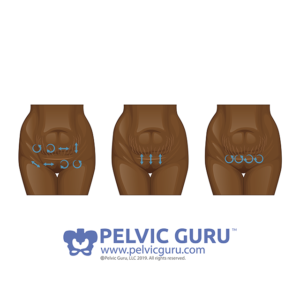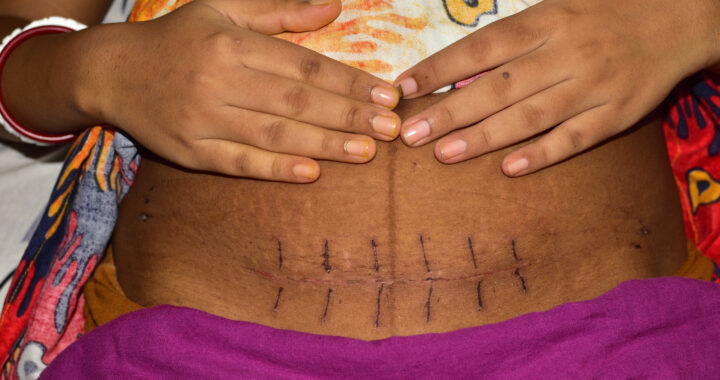You’ve had a C-section- now what?
An estimated 1 in 3 births occurs by Cesarean (C-section). Whether it was planned or unexpected, you may not know what to expect after delivery. Knowledge of your procedure may help you understand the healing process.
What Happens During a C-Section
A C-section is a surgical procedure that involves multiple layers of tissue. If you are squeamish or prefer not to read about the procedure in detail, please skip to the next section. A C-section includes 7 different incisions. The first 3 incisions are transverse (horizontal) and include skin, adipose tissue (fat), and fascia (connective tissue). The next 4 are vertical and include abdominal muscles, peritoneum (more connective tissue), the uterus, and finally the amniotic sac. The bladder is moved downward between the uterine and amniotic scar incisions. See below for an excellent video depicting all of these steps.
Cesarean section explained:
Typical Healing Timeline
A C-section is major abdominal surgery and you will likely need to make some accommodations to your daily routine when healing. There are often questions about what to do in the first few weeks postpartum as you are caring for a new baby and your own healing body. One of the most important things you can do is to show yourself and your body grace and compassion as you recover. We have provided some basic guidelines to help you navigate this exciting and often scary postpartum time. Always consult your OB/GYN for questions but here are a few tips to help you begin moving and feeling better soon after baby.
Sleep, hydration, and nutrition play a big role in healing, and focusing on them will help your recovery. Below is a week-by-week guide to getting you started in your recovery process.

Early Recovery (Weeks 1-4)
Many folks are surprised to experience vaginal bleeding after a C-section, however, this is normal and expected. You may notice bleeding for 2-6 weeks. If you experience excessive bleeding that fills a pad every hour, or bleeding increases unexpectedly, you must be evaluated by your doctor immediately.
Inflammatory Phase (Weeks 1-2)
Inflammation happens in order for the body to bring nutrients to the injured area to begin healing. Focus most on rest, hydration, and nutrition. You can also begin deep breathing exercises for 30-60 seconds at a time where you lie or sit comfortably and inhale slowly through the nose and exhale through pursed lips as if you were breathing through a straw.
Initially, you may experience discomfort around your incision. One way to protect your incision and decrease pain is to splint by gently pressing and holding a pillow or towel over your abdomen when you cough, sneeze, have a bowel movement, stand up, or get in and out of bed. Using a log roll technique can make getting in and out of bed more comfortable during the first few weeks postpartum.
Getting in & out of bed after birth:
Proliferation Phase (Weeks 2-4)
The body begins sending other types of cells and nutrients to bring the wound back together and lay down scar tissue. This is a great time to begin gentle aerobic exercise (i.e. 5-20 minutes walking 5 days/week ) to encourage blood flow and muscle activity.
Maturation Phase (Weeks 4+)
The body rebuilds and reorganizes collagen fibers to strengthen the healing wound.
Later Recovery (Weeks 4-6 and Beyond)
Scar Mobilization and Desensitization

Permission to use copyright image from Pelvic Guru LLC
Once your scar is completely healed, you may begin scar mobilization and desensitization techniques. Scars can become hypo- (less) or hyper- (more) sensitive and these techniques can help normalize your sensations and reduce fear of touching your scar. Sometimes it can feel really difficult to even think about touching your scar. If this is the case, you may start by simply looking at your scar in the mirror. Then, gently and lightly touch it with your hand. Once touch becomes comfortable, you can begin to add a little more pressure and gently move and stretch the scar in all directions (side to side, up and down, and in circles). You may use a little bit of moisturizer, vitamin E oil, or cocoa butter while performing the massage. Try to perform for 5 minutes at a time.
Exercise Progression
Full return to activities and fitness may take 3-12 months. Once your scar has healed, you can begin to do physical activities including strengthening, flexibility, and aerobic exercise. If you are unsure of how to progress your exercise program, a pelvic health physical therapist can design a home exercise program for you.
When to Seek Professional Guidance
If you have any of the following symptoms or you’re unsure of how to begin exercise, a consultation with a physical therapist can help you reach your goals!

Carolina Pelvic Health Center, Inc. offers a free postpartum well visit for all postpartum folks who saw us during their pregnancy. We recommend consulting with a physical therapist around weeks 4-6, but it is never too late to start addressing any lingering concerns! Call us at (919) 571-9912 to learn more about how we may guide you in your recovery.
References:

